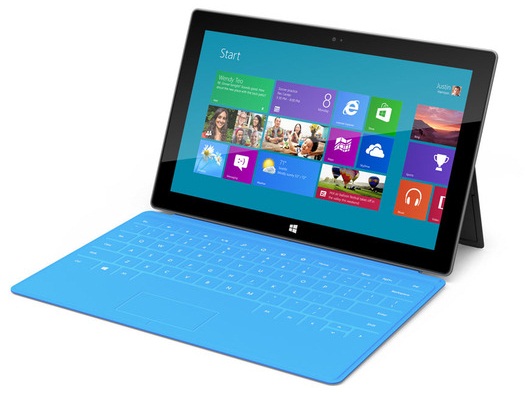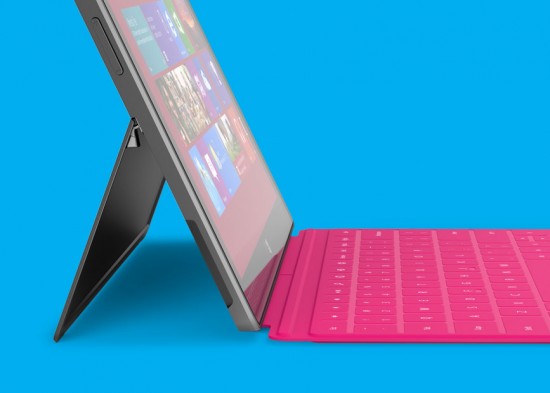A sturdy tablet with a responsive
touchscreen, but what's it like to use?
Microsoft's Surface devices are the first
tablets to be produced by the software giant itself, in an effort to drive
adoption of its Windows 8 platform, albeit at the risk of annoying its existing
hardware partners.
If our experience is anything to go by,
then Microsoft has a potential winner on its hands, as the Surface is
lightweight, well designed and a pleasure to use. It also ships with compelling
features like Microsoft's full blown Office applications built in, while an
excellent add-on keyboard for text entry is an optional extra.

Microsoft
Surface With Windows Rt
We should point out there are actually two
Microsoft Surface models; the Surface with Windows FIT tested here is equipped
with an ARM-based processor and thus runs a special ARM-based version of
Windows 8 known as Windows RT. The Surface with the standard Windows 8 Pro has
an Intel Core i5 processor, but is not yet available.
When looked at in landscape orientation,
there are two tiny speakers on the upper left and right sides of the case, with
an audio jack and volume controls on the left edge, plus a full size USB 2.0
port, micro HDMI output and the power connector on the right side. However,
possibly the most notable feature of the Surface is its built-in kick stand, a
flap that hinges out from the rear of the case and props it up at a convenient
viewing angle when placed on a desk. This is such a simple yet incredibly
useful feature that we are left wondering why every tablet does not have one.
When used in this configuration with one of Microsoft's optional Covers, the
Surface is transformed into a productivity device on a par with an
ultraportable laptop, but much thinner and lighter.

This
is such a simple yet incredibly useful feature that we are left wondering why
every tablet does not have one.
The operating system on this Surface is
Windows RT, which is essentially Microsoft's Windows 8 platform, but ported to
run on ARM-based processors in order to deliver a thinner and lighter tablet
with longer battery life. However, there are differences between the two
versions of the platform, with the most significant being that the Surface with
Windows RT cannot run standard Windows applications.
Under the hood, Microsoft's Surface device
has similar specifications to many high-end tablets, with a quad-core Nvidia
Tegra ARM processor chip, 2GB RAM and 32GB or 64GB of built- in flash storage.
The latter can be expanded via a microSD slot, tucked away behind the kick
stand.

The
latter can be expanded via a microSD slot, tucked away behind the kick stand.
Windows RT seems swift and fluid on this
hardware, responding instantly to touch gestures such as pinch to zoom in our
tests, with the speed of the Wi-Fi internet connection seeming to be the only
thing slowing it down at times. However, the Surface is a Wi-Fi- only device
with no 3G mobile broadband capability, meaning that you need to be within
range of a hotspot to be connected, a factor that is import for a mobile
device, especially one that is so heavily tied to online services.
The Surface's screen has a resolution of
1,366x768 pixels, which is large enough to support app "snapping", so
you can see two app windows on the screen at once. While this is nowhere near
the 2,048x1,536 resolution of Apple's Retina display, we found it perfectly
adequate, and the display quality itself was excellent in all the lighting
conditions we tested in.
The only place the Surface really falls
down is in its two cameras; both the front and rear cameras are 720p, or a
resolution of 1,280x720, which equates to less than 1MP. Not surprisingly, the
images we captured using the Camera app were nowhere near the standard of other
mobile devices, which often have a resolution of 5MP or better.

Like many other tablet vendors, Microsoft
has gone down the route of making the Surface a sealed unit, with an integral
battery pack that cannot easily be replaced or swapped for a fully charged
spare if necessary. However, Microsoft claims that the Surface with Windows RT
offers "all-day" battery life of up to 8 hours from its battery pack,
which is rated at 31.5Whr. This is a realistic expectation, judging by our
tests, as we used the device for several days at a time between recharges,
using it for running Office apps, email, watching videos, and trying out a
sample game or two from the Windows store.
In fact, Microsoft's estimate may be a
little conservative, as we used the Surface to take notes in Microsoft Word during
a 4-hour meeting, after which the battery life had dropped by only 20 percent.
It also recharges quickly, in just a couple of hours in our tests.
It may surprise some readers, but overall,
we found Microsoft's Surface with Windows RT an impressive device that is worth
considering, not least for the built-in Office apps.